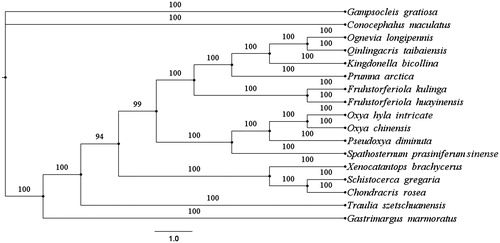Abstract
The complete mitochondrial genome of Fruhstorferiola huayinensis is 16 227 bp in length, and consisted of 13 protein-coding genes (PCGs), 22 tRNA genes, 2 rRNA genes and a control region. In control region, a tRNAIle-like sequence was identified. Additionally, a 259 bp long tandem repeat was identified in the control region. Using the 13 PCGs and 2 rRNA of F. huayinensis, together with 14 other close-related and 2 outgroup species, we constructed BI phylogenetic tree to verify the accuracy and utility of new determined mitogenome sequences.
Fruhstorferiola huayinensis belongs to Catantopidae, Orthoptera. Eight species of the genus Fruhstorferiola are reported so far, and distributed mainly in China (Feng et al. Citation2004). The specimen of F. huayinensis was collected from Xi’an (Shaanxi, China) in September 2015, and was now deposited in Molecular and Evolutionary Lab in Shaanxi Normal University. The total DNA was isolated from the leg muscle of the specimen using the phenol-chloroform extraction method (Zhou et al. Citation2010). Orthoptera universal mitochondrial primers were used to amplify and sequence the mitochondrial genome (mitogenome) of F. huayinensis (Liu et al. Citation2006). The Staden Package 1.7 was used for the mitogenome assembly and annotation (Staden et al. Citation2000). tRNA genes were predicted using online software tRNAScan-SE 1.21 (Lowe & Eddy Citation1997).
The complete mitogenome of F. huayinensis is 16 227 bp in length and has been deposited in GenBank (accession no. KU668856), and its arrangement was identical to the L. migratoria mitogenome (GenBank accession no. X80245.1). It comprises 13 PCGs, 22 tRNA genes, 2 rRNA genes and one A + T-rich region which could also be termed as control region. However, a tRNAIle-like sequence which is 111 bp in length was identified in the control region, the assumed tRNAIle could be folded into cloverleaf secondary structures but with an intron which is 40 bp in length inserted in the anticodon loop.
The overall base composition of the whole mitochondrial genome was A (43%), T (32.63%), G (10.28%) and C (14.09%) with an AT bias of 75.63%, as generally reported in other orthopteran mitogenomes. The start codons of all PCGs were typical ATN except COI which started with TAT, and the stop codons of all the 13 PCGs were complete (TAA or TAG). lrRNA and srRNA genes are 1312 bp and 834 bp in length separately, and the control region is as long as 1365 bp. In srRNA gene and control region, a 259 bp long tandem repeat was identified using Tandem Repeats Finder 4.07b (Benson Citation1999), and was repeated 2.9 times in the surveyed individual.
To furthermore validate the new determined sequences and annotations, the concatenated mitogenome dataset (PCGs and rRNAs) of F. huayinensis in this study, and together with other 16 species from GenBank, including 14 species from Catantopidae and two ensiferan outgroup species were used to perform phylogenetic analysis ().
Figure 1. The Bayesian inference phylogenetic tree based on mitochondrial PCGs and rRNAs concatenated dataset. GenBank accession numbers: Chondracris rosea NC_019993.1; Fruhstorferiola kulinga NC_026716.1; Gastrimargus marmoratus EU527334.1; Kingdonella bicollina NC_023920.1; Ognevia longipennis NC_013701.1; Oxya chinensis NC_010219.1; Oxya hyla intricate KP313875.1; Prumna arctica GU294758.1; Pseudoxya diminuta NC_025765.1; Qinlingacris taibaiensis NC_027187.1; Schistocerca gregaria NC_013240.1; Spathosternum prasiniferum sinense KM588074.1; Traulia szetschuanensis EU914849.1; Xenocatantops brachycerus NC_021609.1; Conocephalus maculates NC_016696.1; Gampsocleis gratiosa EU527333.1.

Disclosure statement
The authors report no conflicts of interest.
Funding information
This work was supported by the China Postdoctoral Science Foundation under Grant no. 2014M562369.
References
- Benson G. 1999. Tandem repeats finder: a program to analyze DNA sequences. Nucleic Acids Res. 27:573–580.
- Feng L, Sun J, Fu P. 2004. Comparative studise on the male genitalia of the genus Fruhstorferiola (Orthoptera, Aeridoidea). J Nat Sci Hunan Norm Univ. 27:79–83 (in Chinese with an English abstract).
- Liu N, Hu J, Huang Y. 2006. Amplification of grasshoppers complete mitochondrial genomes using long PCR. Chin J Zool. 41:61–65 (in Chinese with an English abstract).
- Lowe TM, Eddy SR. 1997. tRNAscan-SE: a program for improved detection of transfer RNA genes in genomic sequence. Nucleic Acids Res. 25:955–964.
- Staden R, Beal KF, Bonfield JK. 2000. The Staden package, 1998. Methods Mol Biol. 132:115–130.
- Zhou Z, Ye H, Huang Y, Shi F. 2010. The phylogeny of Orthoptera inferred from mtDNA and description of Elimaea cheni (Tettigoniidae: Phaneropterinae) mitogenome. J Genet Genomics. 37:315–324.
